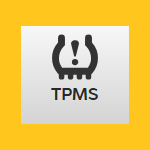 Mitchell 1 provides TPMS information to Modern Tire Dealer, an award-winning publication that writes editorial content geared to independent tire dealers. We’re sharing this content in our blog, with a link to the Modern Tire Dealer website where you can read the article in full. The TPMS information in this article may also be accessed in the reset procedures tab in our ProDemand® auto repair information software, along with other important reset procedure data for the selected vehicle.
Mitchell 1 provides TPMS information to Modern Tire Dealer, an award-winning publication that writes editorial content geared to independent tire dealers. We’re sharing this content in our blog, with a link to the Modern Tire Dealer website where you can read the article in full. The TPMS information in this article may also be accessed in the reset procedures tab in our ProDemand® auto repair information software, along with other important reset procedure data for the selected vehicle.

SUBJECT VEHICLE: 2011 – 2013 Ford Explorer.
RELEARN PROCEDURE? Yes.
SPECIAL TOOLS NEEDED? Yes — a TPMS activation tool (204-363).
The body control module (BCM) of the 2011-2013 Ford Explorer monitors the tire pressure in the four road tires with tire pressure sensors. The tire pressure sensors are battery operated and mounted to the valve stems.
The instrument panel cluster (IPC) illuminates the TPMS warning indicator and the message center displays a message when a fault is present or when the tire pressure falls below the low pressure limit. The programmed tire pressure cannot be changed. NOTE: A scan tool can be useful in diagnosing TPMS concerns and may be used to verify if the TPMS sensors are transmitting accurate tire pressure data by comparing the proportional integral derivative controller (PID) tire pressure data in the BCM to the actual tire pressure using a digital tire pressure gauge. Each tire pressure sensor transmission is compared against a low-pressure limit (pressure listed on the vehicle certification label minus 25%, which will be about 6 psi to 9 psi). If it is determined that the tire pressure has fallen below this limit, the smart junction box (SJB) sends a message to the instrument cluster, which then illuminates the low pressure warning indicator and displays the appropriate message(s) in the message center (if equipped). Under the following conditions, the TPMS may not function properly:
- Low tire pressure.
- Tire pressure sensor is missing or damaged.
- Spare tire is installed as a road wheel.
- Incorrect tire pressure sensor is installed.
- Tire pressure sensor is installed incorrectly.
- Non-OEM wheels are installed.
- Non-OEM run-flat tires are installed.
- Other non-OEM modifications (roll cages, part racks, ladder racks, etc.).
Pressure warning indicators
As ambient temperature decreases by 10 degrees Fahrenheit, tire pressure decreases 1 psi (7 kPa). If tire pressures are not adjusted at cold temperature, the tire pressure may drop enough to be detected by the TPMS, which will activate the low pressure warning light.
When the tire pressure warning light comes on solid and message center displays “LOW TIRE PRESSURE,” check the air pressure of all tires and adjust to the specified cold pressure listed on the vehicle certification label (found on the driver’s door or door pillar). Drive the vehicle at 20 mph for at least two minutes. Make sure the warning light goes off. If the warning light stays on, there is a malfunction in the TPMS. See appropriate manufacturer service information. The TPMS warning indicator flashes for 70 seconds, and then remains on continuously when the ignition is turned to the ON position if the TPMS is malfunctioning. The following messages indicate a system malfunction:
- Tire Pressure Sensor Fault — The message center displays TIRE PRESSURE SENSOR FAULT when a TPMS sensor is malfunctioning.
- No communication with the BCM — The TPMS warning indicator illuminates when the IPC has not received any signals from the BCM for more than five seconds. The message center displays TIRE PRESSURE MONITOR FAULT.
- Tire Pressure Monitor Fault — The message center displays TIRE PRESSURE MONITOR FAULT when the TPMS is malfunctioning. See appropriate manufacturer service information.
Reset procedures
NOTE: Training the sensors is not necessary after a tire rotation on vehicles with the same front and rear tire pressures, but the BCM cannot recognize that the sensor identifiers have been moved to different positions, it only retains the original position the sensors were last trained to. If a tire pressure sensor is replaced, it will need to be trained. Do not use the TPMS reset procedure outlined in the owner’s literature as this procedure will not program new sensors to the module. When the tire pressure warning light comes on solid and message center displays “LOW TIRE PRESSURE,” check the air pressure of all tires and adjust to the specified cold pressure listed on the vehicle certification label (found on the driver’s door or door pillar). Drive the vehicle at 20 mph (32 km/h) for at least two minutes. Make sure the warning light goes off.
Tire pressure sensor training
In the following procedure, a TPMS activation tool (204-363) must be used. NOTE: The tire pressure sensor training procedure must be done on a single vehicle, in an area without radio frequency (RF) noise and at least three feet away from any other vehicle equipped with TPMS. RF noise is generated by electrical motor and appliance operation, cellular telephones and remote transmitters, power inverters and portable entertainment equipment.
If the vehicle has been stationary for more than 30 minutes, the sensors will go into a “sleep mode” to conserve battery power. It will be necessary to wake them up so they will transmit the latest tire pressure information to the BCM. Refer to the TPMS sensor activation section. If a sensor does not respond to the TPMS activation tool, attempt to activate the same sensor with the TPMS activation tool. If the sensor still does not respond, move the vehicle to rotate the wheels at least one-fourth turn and attempt to activate the same sensor again.
The BCM has a two-minute time limit between sensor responses. If the BCM does not recognize any one of the four tire pressure sensors during this time limit, the horn will sound twice and the message center (if equipped) will display TIRE NOT TRAINED REPEAT and the entire procedure must be repeated.
Vehicles with intelligent access:
1) Set the tire pressure of all wheels to the pressure specified on the tire and loading information label.
2) Close all the doors.
3) Turn the ignition switch to the OFF position, and then press and release the brake pedal.
4) Using the START/STOP button, switch from the OFF to ACCESSORY to the RUN position three times, ending in the RUN position.
5) Press and release the brake pedal.
6) Turn the ignition switch to the OFF position.
7) Using the START/STOP button, switch from the OFF to ACCESSORY to RUN position three times, ending in the RUN position. NOTE: It may take up to six seconds to activate a tire pressure sensor. During this time, the TPMS activation tool must remain in place at the valve stem.
8) Place the TPMS activation tool on the left front tire wall at the valve stem.
Press the “TEST” button. The horn will sound briefly to indicate that the tire pressure sensor has been recognized. NOTE: Do not wait more than two minutes between training each sensor or the BCM will time out and the entire procedure must be repeated.
9) Within two minutes after the horn sounds, place the TPMS activation tool on the right front tire wall at the valve stem. Then press the test button to train the right front tire pressure sensor. Repeat the procedure for the right rear and left rear tires, in that order.
10) When the tire training procedure is complete, the message center (if equipped) will display “TIRE TRAINING COMPLETE.” For vehicles not equipped with a message center, successful completion of the training procedure will be verified by turning the ignition switch to the OFF position without the horn sounding. If the horn sounds twice when ignition is turned off, the training procedure was not successful.
Vehicles with an integrated keyhead transmitter:
1) Set the tire pressure of all wheels to the pressure specified on the tire and loading information label.
2) Turn the ignition switch to the OFF position, then press and release the brake pedal.
3) Turn the ignition switch from the OFF position to the RUN position three times, ending in the RUN position. Do not wait more than one minute between each key cycle.
4) Press and release the brake pedal.
5) Turn the ignition switch to the OFF position.
6) Turn the ignition switch from the OFF position to the RUN position three times, ending in the RUN position. Do not wait more than one minute between each key cycle.
NOTE: It may take up to six seconds to activate a tire pressure sensor. During this time, the TPMS activation tool must remain in place at the valve stem.
7) Place the TPMS Activation Tool on the left front tire wall at the valve stem. Press the “TEST” button. The horn will sound briefly to indicate that the tire pressure sensor has been recognized by the driver’s door module. 8) Within two minutes after the horn sounds, place the TPMS activation tool on the right front tire wall at the valve stem. Then press the test button to train the right front tire pressure sensor. Repeat the procedure for the right rear and left rear tires, in that order.
9) When the tire training procedure is complete, the message center (if equipped) will display “TIRE TRAINING COMPLETE.” For vehicles not equipped with a message center, successful completion of the training procedure will be verified by turning the ignition switch to the OFF position without the horn sounding.
Read more:






